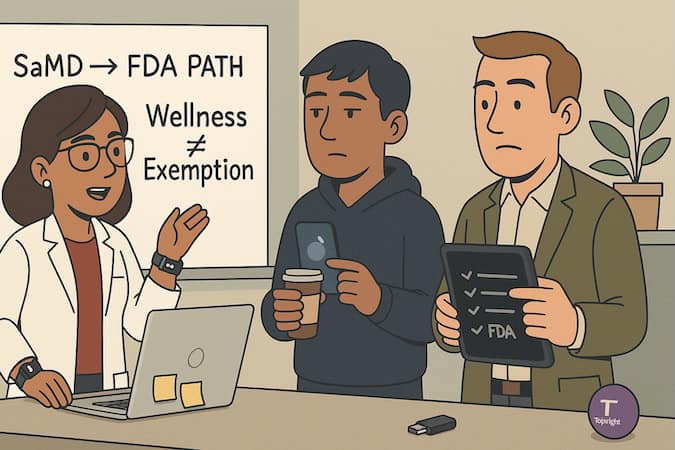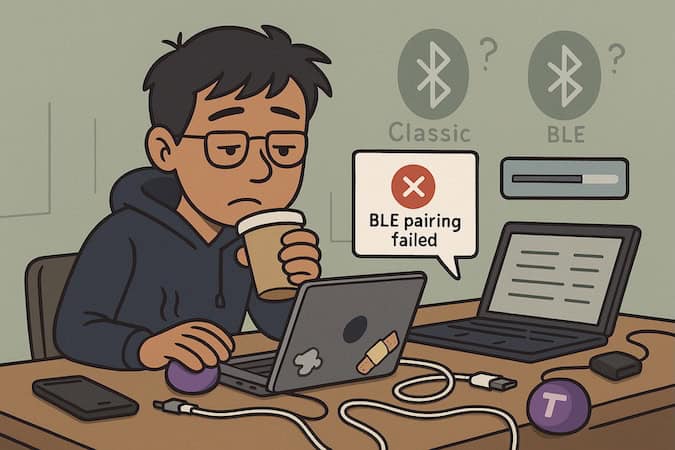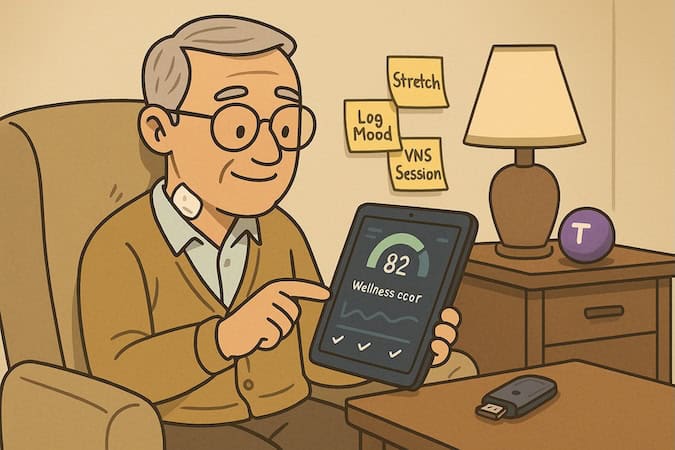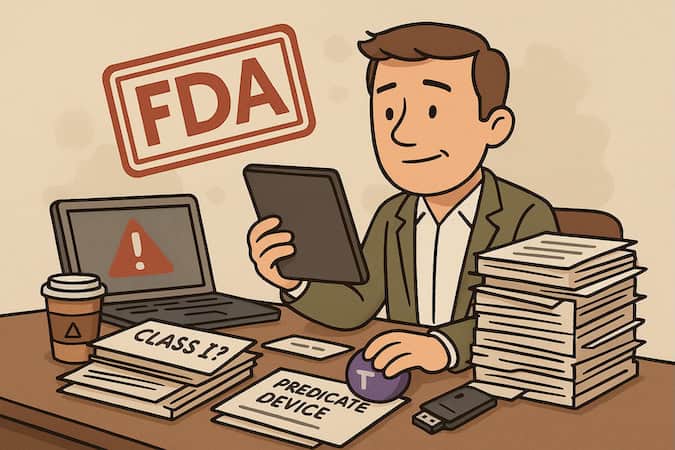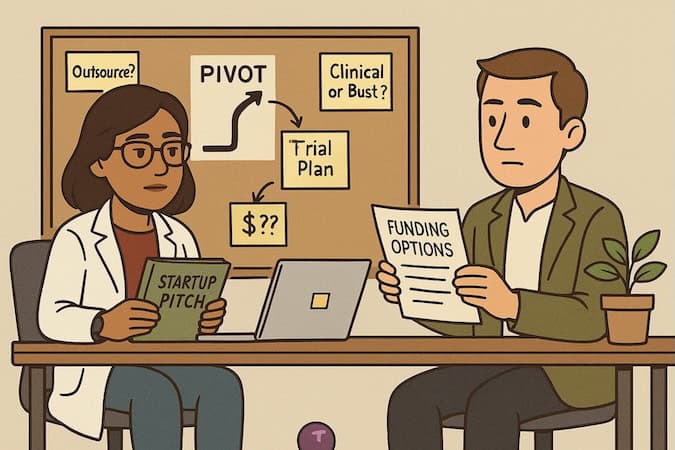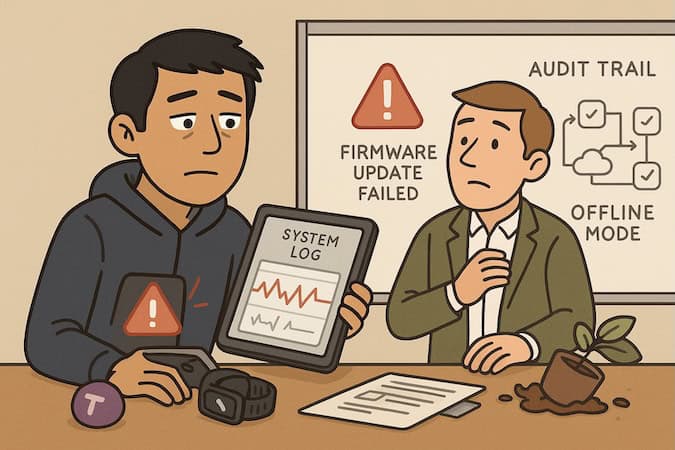If you’re still thinking of your vagus nerve stimulation device’s companion app as “supporting software,” you’re about to walk into a regulatory buzzsaw.
Today’s VNS platforms aren’t just about finely tuned electrical pulses. They’re ecosystems—hardware, firmware, mobile app, cloud sync, patient alerts, and sometimes even clinician dashboards. And with that shift comes a brutal truth: your app isn’t an optional UI. It’s the front line of therapy delivery. And the FDA knows it.
This blog is the field guide we wish every VNS founder, PM, and dev team had before hitting compile. It’s built from postmortems, FDA battle scars, and real-world product wins. If you’re trying to make your therapy app work in the wild—on real phones, under real conditions, for real people—this is for you.
Key Takeaways
- Your VNS app is a medical device—build it like one, test it like one, submit it like one.
- Bluetooth will fail. Firmware will glitch. The only question is whether your app recovers gracefully.
- FDA reviewers are reading between the lines. If your docs are weak, they’ll assume your software is too.
Table of Contents
- The New Front Line of VNS Therapy
- BLE Integration – 90% Debugging, 10% Therapy
- Designing UX That Earns Trust (and Adherence)
- Getting Through the FDA Gauntlet Without Losing Your Mind
- Cybersecurity Isn’t Optional Anymore
- What Real Founders Wish They Knew Earlier
- App Architecture That Doesn’t Get You Sued (or Bricked)
The New Front Line of VNS Therapy
→ Why software is no longer “just an accessory”
Here’s the big shift: mobile apps that manage or modify therapy for VNS devices are now classified as either Software as a Medical Device (SaMD) or Mobile Medical Applications (MMAs). That’s not semantics. That classification subjects your app to the same regulatory scrutiny as the stimulator itself—including performance data, cybersecurity hardening, human factors validation, and risk mitigation under ISO 14971 and IEC 62304.
In short: if your app can initiate a pulse, adjust a parameter, or display therapy logs, it’s not a “nice-to-have.” It’s a regulated medical device—and you’re now in SaMD country.
What Changed—and Why It Matters
Historically, vagus nerve stimulation devices were self-contained. Think handheld controllers with proprietary firmware. No internet. No user logs. Fewer attack surfaces.
Now? You’ve got:
- Real-time BLE links to a patient’s unmanaged smartphone
- Background therapy triggers
- Cloud-based data dashboards
- Remote firmware updates and OTA patches
That means you’re on the hook for:
- A complete Secure Product Development Framework (SPDF)
- A formal Software Bill of Materials (SBOM) for every embedded and third-party component
- Demonstrable postmarket surveillance and patching workflows
- And full verification and validation testing across a matrix of mobile devices, OS versions, and usage conditions
And if you’re thinking, “but we’re just a wearable for stress reduction, not epilepsy or depression…”—bad news. The FDA doesn’t care what you think you’re building. If the intended use implies diagnosis or treatment, you’re in Class II territory.
electroCore’s gammaCore got there with a De Novo classification. Others hit a wall and got smacked with Not Substantially Equivalent (NSE) decisions for failing to prove safety and effectiveness compared to their non-connected predicates.
Regulatory Grey Zones That Trip Up Founders
Even experienced teams fall into one of these traps:
- Accessory fallacy: Treating the app as a non-regulated add-on to the stimulator. Nope. If it adjusts therapy or logs data, it’s regulated.
- Predicate mismatch: Comparing your BLE-connected app to a 10-year-old handheld controller. That’s a recipe for a rejected 510(k).
- Labeling drift: Marketing a stress relief feature while the IFU says “adjunct treatment for depression.” That’s a warning letter waiting to happen.
- Cybersecurity afterthought: Leaving threat modeling and penetration testing until the final sprint. That’s now an automatic RTA (Refuse to Accept) trigger post-Section 524B of the FD&C Act.
What This Means for Your App
The connected vagus nerve stimulation app isn’t an interface. It’s the therapy. And that changes everything—from your UX decisions to your regulatory strategy.
Treat your software as the primary medical device it functionally is. Architect accordingly. Validate everything. And if you’re ever unsure, assume the FDA will scrutinize your app harder than your hardware.
Because in the new frontier of VNS therapy, your mobile app isn’t a helper—it’s the command center. Design—and defend—it like one.
BLE Integration – 90% Debugging, 10% Therapy
→ Why your vagus nerve stimulation app will break in the real world—unless you read this
Let’s get this out of the way: building a BLE-connected app for a VNS device is less about streaming perfect therapy sessions and more about dealing with connection drops, packet loss, and Android bugs that haven’t been fixed since 2017.
You’re not building a generic wearable. You’re building a medical product where one missed packet can cancel a therapy session—and that’s exactly the weak spot in BLE’s default behavior.
Here’s what’s waiting for you in the trenches.
Android BLE: Abandon All Hope, Unless You Queue
Developers new to Android BLE often stumble into the “GATT 133 error”—a cryptic failure that often means: “something broke and we’re not going to tell you what.” One engineer on Stack Overflow called it “the BLE version of a shrug emoji.”
The fix? You need to implement a proper GATT operation queue—Android only allows one BLE request at a time. Send two writes too quickly? You just bricked your session. Tools like Nordic’s BLE library can help, but if you’re using Flutter or React Native, be prepared to write native plugins or debug wrapper bugs for weeks .
iOS, by contrast, quietly queues operations behind the scenes. Which leads to…
The Platform Mismatch Trap
A BLE operation that works perfectly on iOS can silently fail on Android, especially if you forget to:
- Request a higher MTU (Android defaults to 23 bytes; iOS negotiates more automatically)
- Wait for characteristic write callbacks before sending the next command
- Use foreground services to maintain connection during therapy sessions
And if your team’s testing mostly happens on iPhones? Your Android users are going to have a bad time.
We’ve seen this firsthand: when rebuilding the Joovv light therapy app (official San Francisco 49ers’ partner), reverse-engineering BLE commands from legacy devices wasn’t just a one-time challenge—it meant re-architecting a reliable cross-platform BLE layer that played nice with both modern phones and decade-old hardware. BLE parity? Easier said than done.
OTA Updates: The Quiet App-Killer
Let’s talk about Device Firmware Updates (DFUs) over BLE. These are long, fragile transfers with all the ingredients for disaster:
- A mid-update disconnect
- A bootloader that appears with a different MAC address
- A phone call that suspends your app
- iOS background limits throttling packets silently
A common developer complaint: “DFU fails at 99% and leaves the device unresponsive.” You can’t ship that to patients.
Mitigation tips:
- Use battle-tested DFU libraries (e.g. Nordic’s)
- Prevent phone auto-lock and interruptions during DFU
- Plan for bond-preserving DFUs if your device uses encryption
- Implement watchdogs and resume logic for retries
Still think BLE is “low energy”? Wait until you’re transferring 1MB firmware at 20 KB/s while praying the phone doesn’t go to sleep.
Dual-Connection Devices = Double the Pain
Some VNS devices use both BLE and Bluetooth Classic. One for control, the other for streaming audio. Sounds clever—until you realize iOS gives you almost zero visibility into Bluetooth Classic from inside the app.
If your device needs both:
- Expect users to pair twice (once in Settings, once in-app)
- Test edge cases relentlessly—what happens if one connection drops mid-session?
- Seriously consider simplifying to BLE-only unless absolutely necessary
Many teams learned the hard way: the more wireless links, the more surface area for bugs.
Real-World Hiccups You’ll Only See After Launch
No matter how good your QA is, you’ll still get these:
- Android phones with aggressive battery optimizers silently killing background BLE
- iOS rejecting your preferred connection interval and adjusting it mid-session
- Users with smartwatches, earbuds, and glucose monitors saturating BLE limits
- OTA updates failing in hotels and conferences due to RF noise
That’s why smart devs bake in:
- Connection watchdogs (auto-reconnect if no packets in X seconds)
- User education during pairing and DFU (“keep phone nearby, do not switch apps”)
- Offline mode fallback when cloud dependencies aren’t available (shoutout to Pulselibre)
You Can’t Abstract Away BLE—So Build Around Its Flaws
No SDK or cross-platform wrapper will save you from the BLE quirks that matter in VNS. Instead, own them:
- Design with simplicity: one device, minimal commands, no unnecessary services
- Avoid relying on OS features that might get killed (e.g. background scans)
- Validate on real hardware—not just emulators or flagship devices
Because in neuromodulation apps, failure isn’t just a bad UX—it’s a therapy interrupted.
What to Expect When You’re Debugging
If you take one thing from this: the “BLE part” is not a minor sprint. It’s a full-stack reliability challenge across firmware, mobile, and user behavior. And 90% of your time will be debugging weird edge cases.
So allocate the time. Build the test matrix. Log everything. And when in doubt, assume the phone will do the dumbest thing possible—and plan for it.
Designing UX That Earns Trust (and Adherence)
→ Engagement without gimmicks, therapy without confusion
The fastest way to tank a vagus nerve stimulation therapy app? Treat it like a wellness tracker with too many buttons and not enough feedback. When therapy is invisible (you can’t “feel” your vagus nerve doing its thing), the interface has to carry the trust load. And it has to do it without overwhelming or annoying the user.
Let’s break down what actually works—and what’s guaranteed to backfire.
Show, Don’t Just Stimulate: Biometric Feedback That Feels Real
You can’t build long-term adherence on faith alone. Patients want to see that it’s working. The best VNS apps lean on lightweight biometrics—especially HRV before-and-after readings using the phone’s camera. That five-second moment of feedback after a session (“your vagal tone improved 11%”) hits harder than any popup badge or checkmark.
Think of it as a mini dopamine loop: therapy > measurable change > affirmation. No extra wearables needed.
Onboarding That Gets to the “Aha” Moment—Fast
First-session UX is everything. The most successful apps (like Vagustim and Pulsetto) don’t dump you into a 10-screen tutorial or ask you to set 17 preferences. They ask one simple question: What do you want to fix? Stress? Sleep? Digestion?
Then they tailor the experience around that goal—from the education modules to how they visualize progress. The goal is simple: get users to feel something beneficial in their first or second session. That’s your hook.
Gamification, But Grown-Up
We’ve seen plenty of streak counters and achievement badges—but the ones that work treat VNS therapy like a lifestyle, not a game.
- Unlock features after 7, 30, 90 days
- Give “session quality” feedback based on biometric response
- Visualize long-term trends, not just daily checkmarks
What you don’t want is a dashboard that looks like Duolingo meets FitBit meets stock trading. Keep the motivation internal—build progress loops, not pressure.
Don’t Let the UI Undermine the Therapy
Here’s where things unravel fast:
- Over-configurable settings: letting users tweak frequency from 1–1000 Hz with zero context = decision paralysis.
- Multiple ambiguous “modes”: stress, burnout, focus, sleep… with no real difference between them. Users feel lost.
- Tiny fonts + no pause button: yes, we’ve seen this in real apps. If a therapy session gets interrupted and can’t be resumed, users just stop trying.
And whatever you do—don’t lock essential functionality behind a vague subscription wall. One VNS app advertised itself as free but randomly reverted to trial mode, losing session logs. That kind of friction kills trust instantly.
Bluetooth Pairing UX Can Make or Break Retention
Pairing should never feel like a mini escape room.
Use:
- Visual setup flows with device signal strength
- Connection status color-coding (green = go, yellow = idle, red = retry)
- Persistent indicators during session (“Connected and active” = peace of mind)
Offline-first architecture is also non-negotiable. If your app can’t log a session without cell service or Wi-Fi, you’ve just made the therapy unreliable by design.
We’ve Seen This in the Wild…
When we rebuilt the Joovv light therapy app, we saw how critical UX was for hardware-controlled therapy. BLE issues aside, users needed to feel like they were “in control” while also trusting the presets. We implemented progressive disclosure: simple defaults up front, with expert settings hidden behind a tap. The result? Fewer drop-offs, more consistency—and way fewer support tickets.
Build for Real People, Not Product Tours
Real users aren’t developers or clinicians. They’re overworked parents trying to de-stress before bed, or chronic pain patients managing routines. The UX needs to meet them where they are:
- Big buttons
- Short copy
- No jargon
- Always-on clarity about what’s happening now and what just happened
This isn’t just good design—it’s good therapy adherence.
What Trustworthy UX Feels Like
- One tap to start
- Instant, tangible feedback
- Zero stress when connections hiccup
- Progress that feels earned—not bought
The apps that pull this off don’t win because they “look better.” They win because they feel safer. And in VNS therapy, that’s what earns the second session. And the third. And the next 90.
Getting Through the FDA Gauntlet Without Losing Your Mind
→ The fatal five mistakes that sink 510(k) submissions for connected VNS apps
You can ship a working VNS app. But can you get it cleared? That’s the real test—and the graveyard of many good builds. Here’s what sinks connected VNS submissions most often, and how to bulletproof yours before the FDA even opens the PDF.
The Fatal Five: What Actually Gets You Rejected
These aren’t minor paperwork fumbles. These are hard stops that trigger RTA letters, endless AI cycles, or worst case, NSE rejections.
1. Inconsistent IFU
FDA reviewers hate mixed signals. If your Indications for Use don’t match—across cover letter, 510(k) summary, app store copy, and UI labels—expect a fast trip back to the drawing board.
2. Missing Performance Data
Bench testing “in progress”? That’s an automatic no. Your mobile app needs full software V&V docs: SRS, SDS, trace matrices, risk linkage, the works. Especially if you’re controlling stimulation via BLE.
3. Inadequate Risk Management
ISO 14971 isn’t optional. If you’re not showing complete hazard analysis—including software-specific risks, cloud risks, mobile UX edge cases—you’re not getting through.
4. Weak Device Description
Your submission must tell one clean, connected story—from implant to app to cloud. That means diagrams, data flows, security layers. If reviewers can’t mentally trace a therapy session from phone tap to pulse train, you’re in trouble.
5. Ignoring FDA Guidance
Outdated templates, missing cybersecurity annexes, or ignoring human factors guidance = instant red flag. FDA reviewers are trained to interpret what you don’t include as a sign of QMS rot.
The SPDF / SBOM Tightrope
Thanks to Section 524B of the FD&C Act, your VNS app is now a “cyber device”. That means new must-haves:
- SBOM: Not just a list. You need a real-time plan to monitor every open-source and proprietary component for vulnerabilities.
- Threat Model: Must span implant, app, cloud, and even OTA workflows.
- Pen Testing: Yes, even for a mobile app. Bonus points if you patch pre-submission.
- Postmarket Plan: What happens when an Android update breaks your BLE stack? You need a response playbook before launch.
Pro tip: Don’t treat security like an add-on. FDA now views weak cybersecurity as a product risk—not just a privacy issue.
Audit Trails and the “Unmanaged Device” Trap
21 CFR Part 11 isn’t just for clinical software. If your app stores or modifies therapy data, you need:
- Unalterable, time-stamped audit logs
- User-level access control
- Validation plans that actually validate
And yes, if your app runs on patient-owned phones, you must account for:
- Alerts that get silenced or lost
- Bluetooth dropouts during therapy
- iOS/Android update chaos
- Random app-killers nuking background processes
Fix this with critical alert APIs, rigorous compatibility testing, and realistic HFE studies. FDA’s seen too many apps fail in the wild because “it worked on the dev team’s iPhone.”
FDA Reviewers Aren’t Just Looking for Gaps—They’re Reading for Culture
A sloppy IFU? That’s not just a doc error—it tells the reviewer your QMS is likely broken. Missing V&V data? Signals that you’re shipping first and validating later. FDA reviewers are trained to read these gaps as systemic.
What gets through? Submissions that feel like they were assembled by a team that understands—not just checks—the rules.
Cybersecurity Isn’t Optional Anymore
→ How to bake in compliance before your app gets rejected
You can’t “patch” cybersecurity onto a VNS app later. Not anymore. Since Section 524B of the FD&C Act went live, the FDA has the power—and the mandate—to bounce your submission if your app doesn’t prove it can withstand modern threats.
If your VNS system connects via Bluetooth and talks to a cloud server (hint: it does), you’re building what the FDA now calls a “cyber device.” That means new rules, new documentation, and zero margin for hand-wavy security claims.
Your New Checklist Just to Get Through the Door
If your submission is missing even one of the following, you’ll get a Refuse to Accept (RTA) letter before an FDA reviewer even opens your app screens:
- A complete Software Bill of Materials (SBOM)
Not just a list—FDA wants a versioned, machine-readable inventory with your monitoring plan for vulnerabilities in open-source and third-party code. - A Secure Product Development Framework (SPDF)
Evidence that security was designed in, not bolted on. You’ll need to show your threat models, security test protocols, results from penetration testing, and how it all connects back to your QMS. - A postmarket cybersecurity plan
FDA expects you to describe how you’ll detect and respond to new vulnerabilities in the field—including a coordinated vulnerability disclosure policy. - Penetration testing and vulnerability scanning results
FDA doesn’t trust your unit tests. They want objective evidence from qualified ethical hackers who’ve tried to break your system—implant, app, cloud, and all.
Bluetooth ≠ Security
Founders often assume that native OS pairing, encryption, and iOS/Android sandboxing are enough to satisfy regulators. They’re not. BLE security is fragile by design—just Google “KNOB attack” or “BLESA vulnerability.”
If a bad actor can spoof your device’s MAC address and trigger stimulation or access therapy logs, that’s a patient safety event. If you don’t catch that in your threat model, FDA will.
Watch the Weakest Link: Patient-Owned Devices
One of the most overlooked risks in VNS submissions? The fact that therapy is being delivered and logged on unmanaged smartphones. You’re relying on the user’s personal iPhone or Android device—complete with battery-saving features that may kill your background connection, “Do Not Disturb” modes that can silence critical alerts, and god-knows-how-many other apps that interfere with Bluetooth stability.
Don’t just test your app on a clean device in the lab. You’ll need V&V coverage across:
- Multiple OS versions and phone models
- Sleep mode and low battery edge cases
- Incomplete therapy delivery from connection loss
- Alert override logic (e.g., iOS critical alert API usage)
Pro Tip: Build Your Submission Like the FDA Thinks
FDA reviewers aren’t just looking for compliance checkboxes—they’re trained to interpret missing cybersecurity documentation as a symptom of deeper QMS failures. The SPDF isn’t just about code hygiene; it’s a test of whether your organization actually understands and manages system-level risk.
If your dev team is pushing security to “later,” that’s your biggest vulnerability.
TL;DR: Don’t Get 524B’d
Cybersecurity is now central to FDA acceptance—not a separate appendix. You need to prove that your VNS system is secure at every layer: app, Bluetooth, cloud, and backend tooling.
What Real Founders Wish They Knew Earlier
→ Fundraising, FDA, and when to not build it yourself
Let’s be real: most VNS founders didn’t come from medtech accelerators. They came from personal urgency, hard science, or chronic frustration with the status quo. That’s their superpower. But it’s also why so many of them get ambushed by the practical stuff—FDA timelines, Bluetooth hell, cloud costs, clinical trial red tape, and whether to outsource or DIY.
Here’s what some of them have learned—so you don’t have to repeat their mistakes.
You Don’t Need to Build Everything In-House
Almost every successful founder we talked to outsourced at least one critical piece—firmware, app dev, or regulatory submission support.
Spark Biomedical, for example, outsourced early design work to keep the core team lean and focused on clinical validation. Instead of stretching thin to build the whole Sparrow Ascent ecosystem themselves, they brought in outside experts to streamline FDA interactions, UX decisions, and prototype iterations.
Lesson: Own your clinical insight and product vision. Rent the rest—especially if it speeds up your time to IRB or MVP.
Plan for the FDA Before You Have a Product
Multiple founders told us they wished they had mapped out their regulatory pathway before touching hardware or writing a single line of app code.
Nēsos made FDA strategy a core thread from day one, even pre-prototype. It paid off: their breakthrough designation for rheumatoid arthritis helped position them for clinical trials and $16.5M in follow-on funding.
Lesson: Even if your app “just” controls stimulation or tracks logs, it can still trigger SaMD classification. If you design before classifying, you may have to start over.
Crowdfunding ≠ Easy Mode—But It Can Be Smart
Pulsetto moved fast—9 months from idea to shipping a consumer-grade VNS wearable. They didn’t wait for VC buy-in. Instead, they launched via Indiegogo and pulled in $400k+ in preorders, validating the stress/sleep use case before going full clinical.
What made it work? Personal founder stories, simple outcomes, and good industrial design. But they still ran into issues with wearable fit, PCB revision cycles, and Bluetooth reliability—proof that fast doesn’t mean frictionless.
Lesson: If you’re going B2C first, make sure your industrial design and pairing UX are airtight. And don’t treat crowdfunding as market validation unless you’re actually ready to scale.
Everyone Underestimates Cloud Costs and Connectivity Chaos
Founders consistently flagged this: HIPAA-compliant cloud infra, OTA update support, patient data encryption, and regional storage requirements will sneak up on you.
We’ve seen teams spend six figures building out AWS infrastructure when a simpler edge-sync model would have done the job. Others hardcoded region-specific servers, then hit a wall when they tried to expand outside the US.
Lesson: Design for edge-first and offline-friendly operation from day one. Log locally, sync safely, and never make therapy dependent on the cloud.
Bonus: The MVP Isn’t Just for Testing Features—It’s for Testing Teams
The best founders didn’t just use MVPs to test product-market fit. They used them to test development partners, regulatory advisors, and even manufacturers.
- Does your app partner know how to get through a Bluetooth audit?
- Does your firmware team speak human factors fluently?
- Will your manufacturing partner show up after the first 1,000 units ship?
Lesson: Use your MVP as a dry run for your entire product stack—not just the tech, but the humans too.
Now you know what most VNS founders wish they did. Use it.
App Architecture That Doesn’t Get You Sued (or Bricked)
→ Resilience, audit trails, offline mode, and OTA logic
If your app bricks a VNS device mid-session or forgets to log a therapy adjustment, you’re not just looking at a support ticket. You’re looking at regulatory blowback, patient harm potential, and possibly an NSE from the FDA.
In our work with Dedica, an RPM system for cardiac patients, we had to build a full HIPAA-compliant backend with device provisioning, audit trails, and real-time sync for patient vitals. These principles—traceability, fault tolerance, auditability—apply even more in VNS apps where the app is the therapy interface.
This section is your tactical blueprint for building a VNS app that survives the wild—across BLE chaos, OTA flakiness, and compliance scrutiny.
Design Audit Trails Like You’re Already Under FDA Audit
Your therapy logs aren’t “just data”—they’re medical records. That means 21 CFR Part 11 applies. Here’s how to meet it:
- Immutable audit logs: Every session, setting change, and firmware update must be time-stamped, tamper-proof, and uneditable—even by admins.
- Attribution: Unique user credentials only. Shared logins are an automatic fail.
- Redundant logging: Store locally and sync to cloud—don’t depend on one or the other.
- Full validation coverage: Tie your audit trail to traceability matrices and include it in your formal V&V protocol.
Real talk: We’ve seen early builds that overwrote logs every 24 hours to “save space.” That’s a 483 waiting to happen.
OTA Firmware Updates Without the Bricks
We covered the common OTA failure modes earlier (e.g., DFU stalls, iOS backgrounding issues, bootloader reconnection quirks). Now let’s talk about making them survivable.
Design moves that actually work:
- Use proven DFU libraries: Nordic’s iOS/Android toolkits are worth their weight in FDA headaches avoided.
- Graceful reconnection: Many devices reboot mid-update into bootloader mode. Your app must detect and reconnect automatically—even if the MAC changes or the advertised name flips to something generic like DfuTarg.
- Handle bonded DFU: If your device uses bonding, either:
- Ensure bootloader mode supports the same bond credentials, or
- Run DFU in unbonded mode with image signing to verify authenticity.
- Avoid incomplete updates: Architect rollback capability. If a transfer is interrupted, the app must retry or revert, not leave the device stuck between states.
- Prevent OS interference: Block auto-lock and background suspension during updates. Surface clear UX (“Don’t leave the app until finished”) to avoid mid-update failures.
Quick win: Log and display the firmware version pre/post DFU. If the update fails silently, this becomes your user-facing breadcrumb trail.
Plan for Failure Like It’s a Feature
Phones die. Bluetooth drops. Users forget to pair. Your app must expect chaos.
Here’s how to build for it:
- Offline-first BLE logic: Local control must never require an internet connection. Queue commands, timestamp locally, sync when back online.
- Session watchdogs: If the device stops responding mid-therapy, alert the user and trigger reconnection attempts automatically.
- BLE retry rituals: Android BLE still throws GATT 133 errors at random. Build in:
- Retry loops
- Adapter resets
- BLE queues (especially on Android, which doesn’t serialize ops natively)
- Cross-platform testing: BLE behavior changes between iOS versions. Battery optimizers on Android break background connections. Regression test on real phones—especially non-flagships.
Case in point: Pulsetto required cloud login just to start a session. One dev was stuck in a car during a storm with no signal—and couldn’t run therapy. He built an offline open-source clone out of spite. Don’t be that app.
Don’t Architect Yourself Into a Dead End
Avoid single points of failure. That includes:
- Hard cloud dependencies: Core BLE functionality (e.g., stimulation start/stop) must work without hitting your backend.
- No rollback = no mercy: If your app pushes a firmware update with a bug and can’t downgrade, you’re toast. Always support rollback—even if it’s just restoring a stable config profile.
- App versioning strategy: What happens if a user updates the app but not the firmware? Or vice versa? Version mismatches must fail gracefully, with user guidance—not cryptic “device not supported” errors.
One fix: Add compatibility checks before BLE sync. If the firmware version is out of date, inform the user and walk them through a safe OTA flow before proceeding.
✅ Your VNS App Architecture Survival Checklist
- 21 CFR Part 11-compliant audit trail: secure, immutable, attributed
- OTA flow with bootloader reconnect logic, DFU retries, and bonding awareness
- Local fallback and offline queueing for BLE commands
- Watchdog timers to detect connection loss and auto-recover
- Resilience to Android BLE stack quirks and iOS background throttling
- No therapy-critical logic tied to backend uptime
- Firmware + app version sync strategy with rollback support
From day one, your architecture has to assume failure—and recover from it without putting patients or approvals at risk. Design like the worst-case scenario already happened. Because in the field, it will.
Ready to Build Something That Actually Works?
If you’re serious about launching a connected VNS therapy app that won’t crumble under FDA review or BLE hell, let’s talk. We’ve helped founders get from napkin sketch to HIPAA-compliant product—with working firmware, real user trust, and zero fluff.
→ Schedule a strategy call with our team and get the roadmap your product (and patients) deserve.
Frequently Asked Questions
Do I need FDA clearance if my app just controls stimulation parameters?
Yes. If your app initiates, adjusts, or logs therapy, it likely qualifies as a medical device under SaMD or MMA guidelines—even if your hardware already has clearance.
How much should I worry about BLE connection stability?
A lot. BLE failure is the #1 reason VNS sessions don’t complete. Plan for retries, watchdogs, and platform-specific quirks—especially on Android.
What's the most common reason VNS apps get rejected during FDA review?
Inconsistent IFUs and missing validation data. If your app doesn’t have complete traceability and real-world test coverage, you’re at risk for a Refuse to Accept (RTA) letter.
Can I use React Native or Flutter for a VNS therapy app?
It’s possible—but risky. Native BLE control is fragile across platforms, and wrapper libraries often break under real-world therapy conditions. You’ll likely need native modules and deep QA.
What cybersecurity documentation does the FDA now expect?
You’ll need an SBOM, Secure Product Development Framework, pen test results, and a postmarket plan. This isn’t optional under Section 524B—it’s table stakes.
How do I know if I should outsource my VNS app development?
If you’re not confident your in-house team can handle HIPAA compliance, OTA DFU flow, and FDA-ready software documentation, you should at least consult experienced devs before committing.
